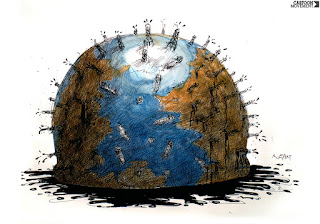The January Brent oil futures contract has broken down in the last 48
hours to approach its late-August lows. It has fallen a little more
than 10% over the past week. The January light sweet crude contract is
also headed south, falling about 12% since the recent high on November 3.
It too has been sold through the October lows. The late-August low was
just below $40.
The main weight continues to be production in excess of demand.
US output may be around 450k barrels less than the June peak, but inventories
are still rising. API estimated crude stockpiles rose 6.3 mln barrels
last week. The EIA, the official estimate is expected to be somewhat
less.,though it recently revised up this year's output forecast.
Meanwhile, news wires have reported that ten Iraqi ships carrying around 19 mln
barrels are headed to the US. This is in addition to the traffic jam
of some 40 tankers off the Texas coast.
The surge of Iraqi oil headed for the US is partly a catch-up after some
local issues in October. Iraq accounted for the bulk of the slippage
of OPEC output last month. According to reports Iraq accounted for 195k
cut in output in October, while OPEC as a whole may have seen a 257k barrel
slippage. Iraq's oil problems seems to be resolved.
OPEC meets on December 4. Given the Saudi's rhetoric, a cut in
quotas is not likely. What could surprise some observers is that OPEC may
increase its quota. The issue is partly technical. Indonesia, which
suspended its OPEC membership in 2009, has rejoined the cartel. Due
primarily to under-investment in its oil sector, Indonesia is no longer
self-sufficient and has to import oil. Its production last year was about
880k barrels a day. To make room for Indonesia, OPEC may increase its
quota by one mln barrels.
Seasonally US refineries step up their activity, and this could increase
the demand for crude. However, it may also simply shift the surplus
to the products. If the refinery demand does not support prices of
crude, it will be seen as another indication of the glut that looks set to
persist.
Russia's output remains strong, and it looks like it may be setting a
post-Soviet era high. Many observers seem to think Putin has outfoxed
the US and Europe, but this may turn out to be a premature
conclusion. Before WWI, the west was the French-German
border. After WWII, it was the west German border. Now, post-Cold
War it is the Baltics. This is to say the West has moved
east.
Russia's alliance with China is exaggerated. The central piece of
China's development strategy is the "One Belt One Road" which
integrates the 'Stans, the underbelly of the former Soviet Union (Kazakhstan,
Uzbekistan, Kyrgyzstan, and Turkmenistan). This is to say the US
and Europe have pushed east against Russia. China is pushing in from the
south. Saudi Arabia has gone for Russia's purse.
Saudi Arabia is rejecting its traditional role as a swing producer
and has helped push Russia into a recession. Adding insult to injury,
Saudi Arabia is now challenging Russia's oil sales in Europe. Russia responded quickly to object to Saudi's attempt to encroach on its
market share in Europe.
Falling oil prices will weigh on headline inflation, and there is likely
some bleeding into core measures. In the currency market, over the
past 60 days, the Russian ruble and the Canadian dollar are the most sensitive
to oil prices (correlations on the percent change basis are 0.75 and 0.55
respectively). Weak oil prices will continue to discourage
investment. However, as we are argued before, with high fixed costs
(which includes debt servicing), companies are incentivized to produce even at
a loss. It will also encourage industry rationalization, which includes
failures as well as mergers.
Disclaimer
Even Light Oil is Heavy
 Reviewed by Marc Chandler
on
November 12, 2015
Rating:
Reviewed by Marc Chandler
on
November 12, 2015
Rating:
 Reviewed by Marc Chandler
on
November 12, 2015
Rating:
Reviewed by Marc Chandler
on
November 12, 2015
Rating:






